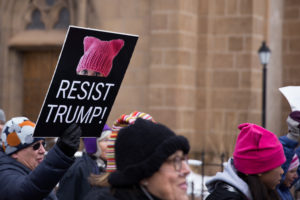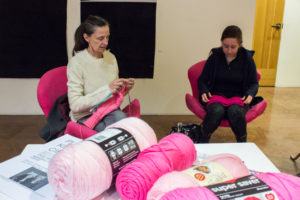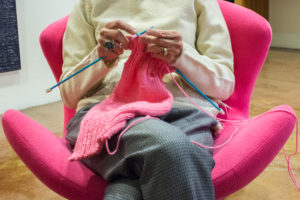Tags
Related Posts
Share This
Pussyhat Phenomenon

Pussyhats at the Santa Fe Women’s March on Washington. Photo by Jason Stilgebouer
Aerial shots of Washington D.C. on Jan. 21st, 2017 show a sea of pink. Streets all over the country are filled with women wearing hats with cat ears, hand knitted, sewn and crocheted, and carrying signs saying, “This pussy grabs back!” The viral trend of “pussyhats” took off in the last couple weeks before the Women’s March on Washington, a protest against the misogyny, racism and xenophobia of newly inaugurated president Donald Trump.
The Pussyhat Project was founded by Krista Suh and Jayna Zweiman in order to give the participants of the march “a means to make a unique collective visual statement” and those who could not march in D.C. “a way to represent themselves and support women’s rights.” Pussyhat makers who could not attend the D.C. march were encouraged to mail any extra hats they had for hatless marchers, not only so they could remotely take part in the protest, but to provide some cozy headwear for marchers on the chilly day of the march. However, as the Women’s March on Washington gained traction, remote marches popped up all over the country and even across the globe. With the march accessible to millions more participants, the demand for pussyhats skyrocketed.
In Santa Fe, by the last few days preceding the march, it was almost impossible to find any pink yarn. Michaels Craft Store seemed to be the only place left with any in stock, and when this reporter went to find some for herself, she ran into a pair of women filling their cart to the bring with any pink yarn they could find. They said they had already made 16 pussyhats and were making even more to hand out at Santa Fe’s Women’s March. They were generous enough to leave a few skeins behind as well as some tips on how to improve the pussyhat pattern.

Hannah Gardner and Linda Swanson knitting pussyhats. Photo by Lexi Malone
On the SFUAD campus, Linda Swanson, dean of the School of Visual and Communication Arts, held a knitting circle in the lobby of Thaw Art History Center from 3-6 the last Wednesday, Thursday and Friday before the march for anyone to stop by and work on their hats. Swanson stated that “for a long time I’ve wanted to hang out with these people [students] and have a space where we can have a very informal conversation, because I think those can lead to real content.” Pussyhat participant Hannah Gardner also values the connection she gains from being part of this movement. “Most political movements that I’ve been a part of have all been online, so seeing that coming together is… it’s fantastic.”
The unity of women through knitting is one that the Pussyhat Project is proud to promote. The fact that the Women’s March on Washington is over has not changed their mission to advocate change through creating. Their website has a locations page that shows local yarn shops in each state. Originally used as drop points for surplus pussyhats during the marches, these places are now locations that can unite knitters and crocheters for positive change. “Historically,” says Swanson, “knitting circles or quilting bees and those things were where a lot of political action happened — the Abolitionist Movement and stuff. So women have found those kinds of events and communities to be very powerful.”

Linda Swanson knitting a pink hat for the Women’s March. Photo by Lexi Malone
Facebook and other online community organization allowed the Women’s March to become a global protest. But through the pussyhats, even people without the ability to attend a march, or those who wanted to be represented in D.C. but could not make the trip, had the chance to participate. “The march in Washington is this kind of concentrated event,” Swanson says, “and I think the knitting of the hats is a distributed event. I think it also speaks to the fact that women all over the country have concerns about their rights and safety… I like that we can do it here and it can be equally as meaningful. It’s a way to connect with that.” The unity of the Women’s March on Washington can be seen and felt across the globe, due in part to the skeins of pink yarn encircling every protest.






 Jackalope Magazine is the student magazine of Santa Fe University of Art and Design. Building on the interdisciplinary nature of our education, we aim to showcase the talent of our university and character of our city.
Jackalope Magazine is the student magazine of Santa Fe University of Art and Design. Building on the interdisciplinary nature of our education, we aim to showcase the talent of our university and character of our city.
Recent Comments